
Research Experiences for Undergraduates in
Information Processing and Decision Making for Intelligent and Secure Environments
Open House 2007

Twelve undergraduate participants of the REU summer program participated in the REU Open House 2007 to present their research projects.
Passive Inhabitant Tracking and Behavior Anomaly Detection

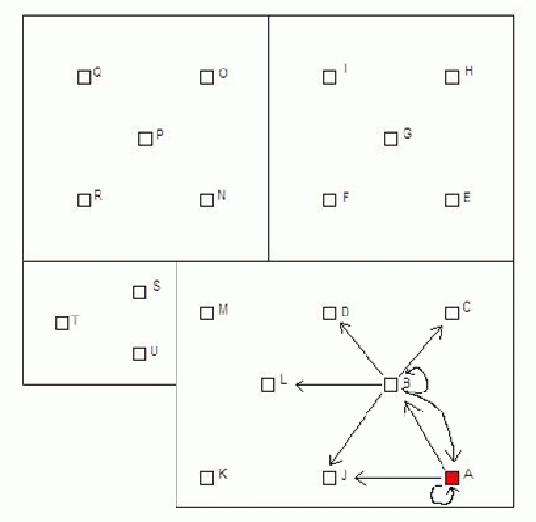 Two
REU students were involved in the development of technologies that
allow the non-intrusive tracking of inhabitants in a home and the
modeling of their normal behavior patterns for the purpose of
detecting unusual behavior. The motivation behind this is that the
detection of unusual behavior can address some of the most pressing
challenges in security sensitive as well as in home environments for
the elderly. In particular, in the former anomalous behavior would
indicate a potential threat while in the latter it can be used to
automatically detect changes due to injury or mental changes and
thus be used to provide early warning signs and make living in the
home safer for the elderly.
Two
REU students were involved in the development of technologies that
allow the non-intrusive tracking of inhabitants in a home and the
modeling of their normal behavior patterns for the purpose of
detecting unusual behavior. The motivation behind this is that the
detection of unusual behavior can address some of the most pressing
challenges in security sensitive as well as in home environments for
the elderly. In particular, in the former anomalous behavior would
indicate a potential threat while in the latter it can be used to
automatically detect changes due to injury or mental changes and
thus be used to provide early warning signs and make living in the
home safer for the elderly.
In this project, the two students worked collaboratively on developing a framework for behavior modeling and anomaly detection using Hidden Markov Models and Active LeZi algorithms. In addition, each student also implemented basic sensing techniques for a different sensor system, in particular for an omnidirectional vision system and a system consisting of an array of passive infrared sensors. The figure shows on the left the view of the omnidirectional camera system used for tracking and on the right a schematic of the infrared sensor layout and the embedded tracking and behavior model for the initial area. The goal of this project was to develop a robust system for voice control for intelligent environments. Such a voice control interface addresses one of the important issues in smart homes, namely the availability of an easy to use and natural interface between the human inhabitant and the devices in the home. The main challenges that had to be addressed for this project were the fact that the system has to operate in the context of ambient noise and in an environment where multiple people might have conversations or where radio or television might introduce conversations that can be on arbitrary topics. The latter leads to the problem that any set of key words used to identify commands might occur naturally during conversation but should be interpreted as commands only when they are intended as such.
Intelligent Air Conditioning and Heating Control
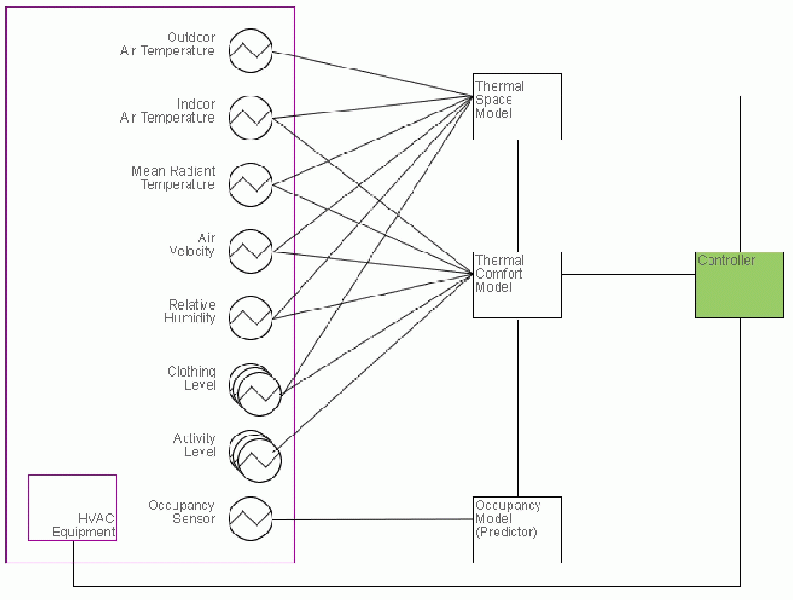 Another
issue of increasing importance in home and commercial environments
is energy efficiency. Since a large amount of energy is used for
heating and air conditioning, the control of these devices is of
major importance. In this project one REU student investigated a
framework for the automatic optimization of heating and air
conditioning controls. The system uses a predictive neural model to
regulate the settings of the heating and air conditioning system
such as to maintain the optimal level according to the comfort model
of the persons occupying the space and is built to accommodate a
component that will automatically learn the coefficients of the
comfort model. The basic model is shown in the figure.
Another
issue of increasing importance in home and commercial environments
is energy efficiency. Since a large amount of energy is used for
heating and air conditioning, the control of these devices is of
major importance. In this project one REU student investigated a
framework for the automatic optimization of heating and air
conditioning controls. The system uses a predictive neural model to
regulate the settings of the heating and air conditioning system
such as to maintain the optimal level according to the comfort model
of the persons occupying the space and is built to accommodate a
component that will automatically learn the coefficients of the
comfort model. The basic model is shown in the figure.
In addition to designing the controller model, the student also designed and implemented a simulation environment that accurately simulated heating and air conditioning in a flexible configurable home environment, and that will be used to investigate the effectiveness of the intelligent heating control architecture.
Intelligent Inventory Control for a Smart Kitchen
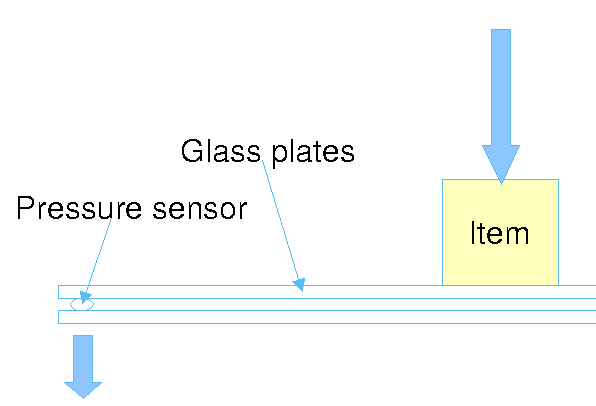 This
project built on previously developed hardware and software and was
aimed at developing a system that can automatically track items and
their amounts as they are put in and removed from a weight sensor
and RFID enabled shelf system in a smart kitchen. One REU student
worked on this project and developed the software architecture and
interfaces to facilitate the item and quantity tracking as well as
an interface between this architecture and a recipe system that
allows to retrieve recipes that can be completed with the items
available in the system. In addition, the student implemented
algorithms to determine the sector in which items were placed on the
shelf using the noisy sensor information and a graphical user
interface that combined the tracking and the recipe recommendation
system in a user friendly manner.
This
project built on previously developed hardware and software and was
aimed at developing a system that can automatically track items and
their amounts as they are put in and removed from a weight sensor
and RFID enabled shelf system in a smart kitchen. One REU student
worked on this project and developed the software architecture and
interfaces to facilitate the item and quantity tracking as well as
an interface between this architecture and a recipe system that
allows to retrieve recipes that can be completed with the items
available in the system. In addition, the student implemented
algorithms to determine the sector in which items were placed on the
shelf using the noisy sensor information and a graphical user
interface that combined the tracking and the recipe recommendation
system in a user friendly manner.
The figure shows a schematic of the load assessment used in the system.
Vein Pattern Recognition Technologies for Secure Home Entry
Secure
and intelligent environments increasingly rely on secure
authentication technologies and in particular on biometrics. In this
project one REU participant investigated different biometric
authentication technologies and then focused on the development and
construction of a vein pattern recognition and authentication
system. Vein patterns are unique across individuals, change
relatively little over an adult's lifetime and are very difficult to
falsify, making them a very effective for biometric authentication.
As opposed to techniques like fingerprint identification, however,
vein pattern based systems are still relatively rare and very
expensive. As part of this project the student constructed hardware
and software for a relatively low cost system consisting of a near
infrared camera, a set of LEDs to provide illumination in the
frequency band most appropriate for the detection of the hemoglobin
in veinous blood, and software to acquire the images and extract
basic vein patterns.

 The
figure shows schematics of the basic hardware setup as well as a
number of pictures taken by the implemented system, illustrating its
capability to extract basic vein pattern information.
The
figure shows schematics of the basic hardware setup as well as a
number of pictures taken by the implemented system, illustrating its
capability to extract basic vein pattern information.
Intelligent Service Robot Control
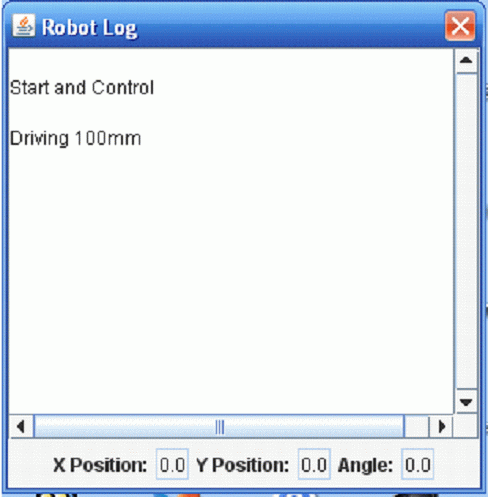
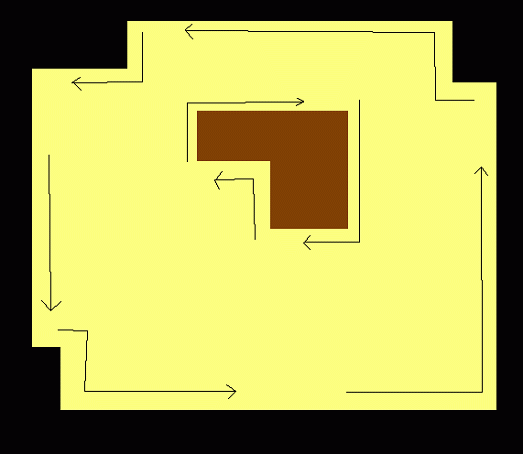 Another
important branch of technologies for intelligent environments is the
one of service robots and in particular of intelligent control
schemes that can deal with the uncertainty inherent in home
environments. In this project one REU student investigated robot
localization techniques and developed a scheme for the automatic
mapping of the environment using a simple Roomba cleaning robot and
a set of virtual walls to establish anchor points that are
detectable using the robot's relatively simple sensors. The goal
here was to deal with the uncertainty using a low cost platform and
the resulting system used carefully designed navigation patterns to
incrementally build a library of known anchor points in the
environment that the robot uses to correct its location estimate.
Another
important branch of technologies for intelligent environments is the
one of service robots and in particular of intelligent control
schemes that can deal with the uncertainty inherent in home
environments. In this project one REU student investigated robot
localization techniques and developed a scheme for the automatic
mapping of the environment using a simple Roomba cleaning robot and
a set of virtual walls to establish anchor points that are
detectable using the robot's relatively simple sensors. The goal
here was to deal with the uncertainty using a low cost platform and
the resulting system used carefully designed navigation patterns to
incrementally build a library of known anchor points in the
environment that the robot uses to correct its location estimate.
The figure shows the basic robot interface to drive the Roomba robot and an example navigation pattern for the construction and use of the anchors.
Adaptive and Secure Personal Computer Interfaces
 Personalization
is an important capability for computer systems in the context of
providing the best access to information possible and allowing
computer systems to be used efficiently by different users. The
importance of this is further increased by the move towards
pervasive computing systems and the need for privacy and security
when dealing with personal information. Throughout the summer, two
REU participants investigated different aspects of personalized
computer interfaces with one of them focusing on the development of
a portable personal desktop and application setup that allows a user
to bring their own setup to a different computer without leaving any
information after logging out. The other project investigated
technologies for the automatic adaptation of the computer interface
using machine learning to address the requirements of the particular
user with particular aim at users with disabilities.
Personalization
is an important capability for computer systems in the context of
providing the best access to information possible and allowing
computer systems to be used efficiently by different users. The
importance of this is further increased by the move towards
pervasive computing systems and the need for privacy and security
when dealing with personal information. Throughout the summer, two
REU participants investigated different aspects of personalized
computer interfaces with one of them focusing on the development of
a portable personal desktop and application setup that allows a user
to bring their own setup to a different computer without leaving any
information after logging out. The other project investigated
technologies for the automatic adaptation of the computer interface
using machine learning to address the requirements of the particular
user with particular aim at users with disabilities.
The figure shows the basic operational flow of Zapplication, a portable personal computer desktop, and a sample desktop for the prototype system.
Advanced Video Compression
One of the most information and data intensive modalities in secure environments is surveillance and communications video, making it essential to have high performance and low cost video compression algorithms. This requirement is further moved to the forefront in pervasive and mobile settings where bandwidth, energy, and computing power is at a premium. In this project, one REU participant investigated modern video compression technologies and developed an enhancement to a preexisting video encoder.
Interactive Multi-Point Video Communications for Law Enforcement
In this project, one REU participant investigated interactive, mobile, pervasive video and audio technologies in the context of COPSE, a system for information exchange for law enforcement. The overall system is intended to provide reliable, real time video, audio, and data communications between police officers, their vehicles, and the police station. Building on a preexisting prototype, the student developed components that facilitate bidirectional video and audio communications between hand-held devices and a more powerful module intended for use on police cars. The main challenges here lay in developing components that provide sufficient quality yet have low computational overhead and that are reliable in the context relatively low power and low bandwidth wireless, battery operated devices in environments with significant wireless interference.
Next Generation Multi-View Videonteractive Multi-Point Video
 Another
issue arising in the context of visual surveillance is the
integration of visual information into easier to analyze
representation for next generation video systems. One of the issues
arising in this is the integration of video from multiple cameras
overlooking the same scene into a single representation that can be
manipulated to obtain the best information. To address this, two REU
participants investigated aspects of multi-view video and developed
a video coding scheme and a viewer that allow the efficient
transmission of multiple video streams taken from different
viewpoints and their integration into a display in which the user
can manipulate the viewpoint used for the display during the replay
of the video.
Another
issue arising in the context of visual surveillance is the
integration of visual information into easier to analyze
representation for next generation video systems. One of the issues
arising in this is the integration of video from multiple cameras
overlooking the same scene into a single representation that can be
manipulated to obtain the best information. To address this, two REU
participants investigated aspects of multi-view video and developed
a video coding scheme and a viewer that allow the efficient
transmission of multiple video streams taken from different
viewpoints and their integration into a display in which the user
can manipulate the viewpoint used for the display during the replay
of the video.
The figure shows the developed interface displaying video containing camera feeds from three different orientations.
For additional information regarding this program please contact:
Manfred Huber
University of Texas at
Arlington
Department of Computer Science and Engineering
Box
19015
Arlington, TX 76019-0015
Email: reu@cse.uta.edu
* This project is funded by NSF grant CNS-0649229